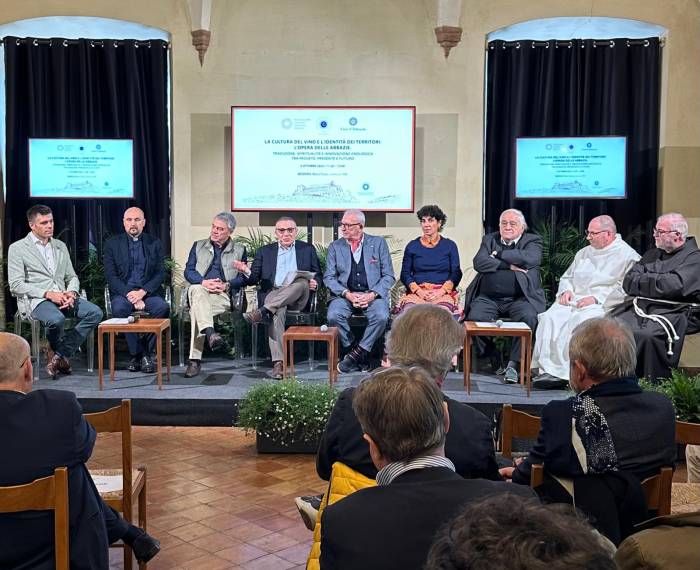Italian Abbeys Highlight Enduring Role in Wine Culture and Regional Identity at Franciacorta Conference
Monastic, academic, and wine communities gather to discuss sustainability, heritage, and the cultural legacy of abbey winemaking traditions
2025-10-06

On October 4, 2025, the Convent of the Santissima Annunciata in Franciacorta, Italy, became the meeting point for monastic, academic, and wine communities during a national conference focused on the relationship between wine culture and territorial identity. The event, titled “The Culture of Wine and Territorial Identity: The Role of Abbeys,” was organized by Vini d’Abbazia and the Vittorio and Mariella Moretti Foundation. It formed part of the Foundation’s “Come in famiglia” program, which offered a full day of open-access activities from early morning until midnight. These included nature walks, workshops, readings, and community gatherings centered on spirituality and culture.
The conference took place under the patronage of Fondazione Italia Patria della Bellezza, an organization that supports projects highlighting Italy’s cultural heritage. The gathering brought together monks, wine producers, oenologists, historians, and public officials to discuss how abbeys have historically protected landscapes and agricultural knowledge while shaping local identities through wine production.
The event opened with a video message from Francesco Lollobrigida, Italy’s Minister of Agriculture. He thanked the monastic communities for their role in preserving traditions that contribute to Italy’s cultural and economic wealth. Lollobrigida emphasized the government’s commitment to supporting enterprises that maintain quality and generate value for the country.
Vittorio Moretti, president of the Foundation, welcomed attendees alongside Valentina Moretti, who is responsible for cultural activities. Both highlighted the importance of sharing spaces like the convent with the wider community to foster unity and reflection on shared values.
Speakers included Renzo Cotarella, CEO of Marchesi Antinori in Florence. He spoke about Badia a Passignano Abbey’s thousand-year-old vine discovered in 1983 and described how art, history, viticulture, and innovation coexist at the estate. Werner Waldboth from the Abbey of Novacella in Bolzano—one of the world’s oldest wineries—stressed that sustainability is central to their operations and that their longevity is rooted in monastic tradition.
Manfred Bernard from Muri-Gries Abbey Winery discussed how continuity is a key legacy for monasteries facing modern challenges. He said that viticulture remains vital as a cultural asset and source of stability. Dom Stefano Visintin from Praglia Abbey near Padua reflected on wine’s historical role as food, sacrament, and medicine within monastic life. He noted that today it also represents respect for nature and tradition.
Don Andrea Santus from Monte Oliveto Maggiore Abbey in Siena described how wine production continues to be linked to liturgy and work within his community. Brother Michele Badino from the Monastery of Bose in Assisi shared his experience rescuing an old native vine through organic practices as an expression of care for both land and spirit.
Academic voices included Attilio Scienza, Professor of Viticulture at the University of Milan. Father Luigi Cavagna, Franciscan monk at Rodengo Saiano and Rector of Accademia Symposium, also participated. The conference was moderated by RAI journalist Rocco Tolfa.
Throughout the day, attendees had opportunities to taste wines produced by various abbeys at stations curated by AIS Lombardia. These tastings offered a direct experience of how centuries-old traditions continue to shape local identities through wine.
The Convent of the Santissima Annunciata itself holds historical significance. Entrusted to the Vittorio and Mariella Moretti Foundation by the Order of the Servants of Mary in 2018, it now serves as a center for cultural events and community engagement. The conference highlighted not only the enduring role of abbeys in Italian society but also their ongoing contributions to landscape preservation and agricultural innovation.
Representatives from leading Italian agricultural, religious, and academic institutions attended the event. The discussions underscored how abbeys remain active participants in contemporary debates about sustainability, heritage protection, and rural development. The day concluded with a sense that these historic sites are not just relics but living centers where tradition continues to inform present-day practices in winemaking and community life.
Founded in 2007, Vinetur® is a registered trademark of VGSC S.L. with a long history in the wine industry.
VGSC, S.L. with VAT number B70255591 is a spanish company legally registered in the Commercial Register of the city of Santiago de Compostela, with registration number: Bulletin 181, Reference 356049 in Volume 13, Page 107, Section 6, Sheet 45028, Entry 2.
Email: [email protected]
Headquarters and offices located in Vilagarcia de Arousa, Spain.